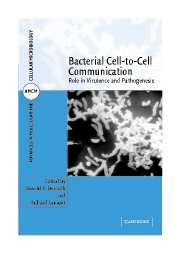Book contents
- Frontmatter
- Contents
- List of Contributors
- Preface
- 1 Quorum sensing and regulation of Pseudomonas aeruginosa infections
- 2 The Pseudomonas aeruginosa quinolone signal
- 3 Quorum-sensing-mediated regulation of plant–bacteria interactions and Agrobacterium tumefaciens virulence
- 4 Jamming bacterial communications: new strategies to combat bacterial infections and the development of biofilms
- 5 Quorum-sensing-mediated regulation of biofilm growth and virulence of Vibrio cholerae
- 6 LuxS in cellular metabolism and cell-to-cell signaling
- 7 LuxS-dependent regulation of Escherichia coli virulence
- 8 Quorum sensing and cell-to-cell communication in the dental biofilm
- 9 Quorum-sensing-dependent regulation of staphylococcal virulence and biofilm development
- 10 Cell-density-dependent regulation of streptococcal competence
- 11 Signaling by a cell-surface-associated signal during fruiting-body morphogenesis in Myxococcus xanthus
- Index
- Plate Section
- References
8 - Quorum sensing and cell-to-cell communication in the dental biofilm
Published online by Cambridge University Press: 08 August 2009
- Frontmatter
- Contents
- List of Contributors
- Preface
- 1 Quorum sensing and regulation of Pseudomonas aeruginosa infections
- 2 The Pseudomonas aeruginosa quinolone signal
- 3 Quorum-sensing-mediated regulation of plant–bacteria interactions and Agrobacterium tumefaciens virulence
- 4 Jamming bacterial communications: new strategies to combat bacterial infections and the development of biofilms
- 5 Quorum-sensing-mediated regulation of biofilm growth and virulence of Vibrio cholerae
- 6 LuxS in cellular metabolism and cell-to-cell signaling
- 7 LuxS-dependent regulation of Escherichia coli virulence
- 8 Quorum sensing and cell-to-cell communication in the dental biofilm
- 9 Quorum-sensing-dependent regulation of staphylococcal virulence and biofilm development
- 10 Cell-density-dependent regulation of streptococcal competence
- 11 Signaling by a cell-surface-associated signal during fruiting-body morphogenesis in Myxococcus xanthus
- Index
- Plate Section
- References
Summary
INTRODUCTION
The microbial community that exists in the oral cavity is perhaps the most accessible, complex and pathogenic of the naturally occurring human biofilms. Over 500 different species of bacteria have been identified in the mature biofilm that forms on tooth surfaces (38). This complex community tenaciously adheres to and develops on the acquired salivary pellicle, a conditioning film of salivary proteins and glycoproteins adsorbed to oral tissue surfaces. The initial colonizers of the salivary pellicle are predominantly Gram-positive facultative anaerobes such as the streptococci; these organisms normally exist in commensal harmony with the host. However, as the oral biofilm matures, there is a change in the microbial composition, with an increasing presence of Gram-negative organisms. The two most common oral diseases in humans, dental caries and periodontal disease, arise from populational shifts in the biofilm in response to a variety of host and/or environmental stimuli. This results in over-representation of pathogenic organisms in the biofilm at afflicted sites in the oral cavity. For example, excessive consumption of dietary sucrose favors the overgrowth of highly fermentative acidophilic organisms such as Streptococcus mutans. The acidic local environment generated by these organisms promotes demineralization of the hydroxyapatite matrix of enamel, thus increasing the risk of dental caries. In contrast, periodontal disease is caused by a biofilm that thrives in the subgingival pocket and induces a chronic inflammatory condition that results in the destruction of the connective tissues and bone that support the teeth (23).
- Type
- Chapter
- Information
- Bacterial Cell-to-Cell CommunicationRole in Virulence and Pathogenesis, pp. 175 - 198Publisher: Cambridge University PressPrint publication year: 2006



